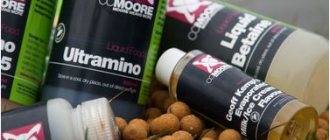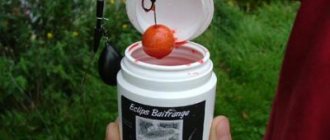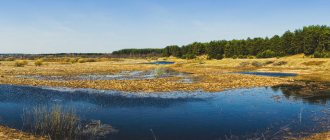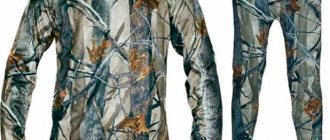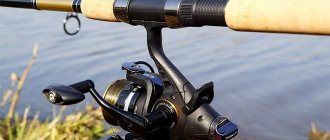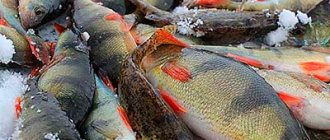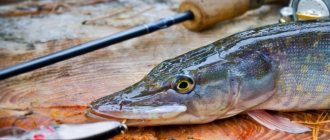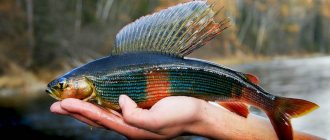Fish luring or nutritional value
From English, dip is translated as immersion, dipping, deepening, and these are the words that can describe the method of its use: the bait is dipped into a fragrant liquid and acquires some new positive qualities. Ever since the birth of modern carp fishing (and maybe even earlier, but we don’t know about it), it was noticed that food that was treated with some kind of dip before entering the water can attract much more attention from the fish. In this case, almost any scent can be used. For example, it could be a garlic sauce in which pieces of hominy are dipped, honey or tuica (fruit vodka among Romanians and Moldovans) in which corn grains are dipped, or a synthetic flavor in which boilies are softened - all of them are dips. The first such products that began to be used in carp fishing were very aromatic liquids with the simplest luring effect. Before casting, the bait was dipped into such a dip for some time and acquired an intense, but short-term aroma. The dip time was limited - if the bait was in the liquid for too long, it could become so saturated with the aroma that, instead of attracting fish, it would start to scare them away.
Simultaneously with the gradual appearance of nutritious liquids in the arsenal of carp fishermen (I said “gradual”, since the history of their market conquest stretches for more than 30 years: from the appearance of Minamino in the 70s to CSL in the 80s and soluble fish protein L-030 in the 90s 's), a new direction is being developed to increase the attractiveness of baits - nutritious or nutritional dips. These are products with radically different recipes and ways of using them. The contact of the bait with the dip should no longer be short; rather, on the contrary, it becomes more effective the longer it is in the nutrient liquid. And not only bait - nutritional dip can make bait more attractive to fish as well.
I would like to emphasize right away that the primary effect of using a nutritional dip is, as in the case of conventional dips, luring fish, but using softer, more natural and therefore, in fact, more effective means. Otherwise, the terms can mislead someone, since no one wants to feed the fish, everyone only wants to catch them. We don't need nutritional qualities, we want a quick luring effect. At one time I even conducted such a test - I asked different fishermen what they preferred: a dip with a quick attractive effect or a nutritious dip. And it didn’t come as a surprise to me that people react to the phrase “long-term baiting” without understanding what they are getting. But in fact, nutritious dips attract carp even better than regular dips, in addition, they are more stable and have the advantage that they are perfectly combined with small doses of aromas, due to which they transmit food signals more effectively.
Oil based dips
Classic bait dips are oil-based dips with a lot of flavoring. These were the first commercial dips to hit the market and, being a fast-acting product, they still remain popular, especially among those anglers who prefer short sessions. They are very convenient because they do not require any preliminary preparation. You take the boilie out of the bag, dip it in the dip for a short time (the soaking time, depending on the manufacturer, can vary from several minutes to several hours), and it is ready for use. As a rule, the only difference between one such dip and another is the flavoring, and the oil that forms the base of the dip remains the same. There are dips only for bait - their aroma is too strong to be used in food. But they can be a very good choice when fishing with isolated baits.
Sticky dips
A special category are dips that are sticky like glue. They also serve only for luring - they have no nutritional value. This is a kind of flavored glue into which the bait is dipped. As a result, the dip forms a sticky, aromatic shell around the bait, which gradually dissolves in water. As you can see, the principle of application is very simple: by simply dipping into the dip, an angler can instantly “remake” any bait - from boilies to corn - sticky dips go with everything. Moreover, the range of such “alterations” can be quite wide - some of the sticky dips are offered in various colors and flavors. But there are also neutral ones, colorless and odorless, for individual selection of fragrances and other components. How to use them? It’s simple - you just need to preheat it a little by lowering the jar of dip into a container of warm water. When the contents of the jar become noticeably more fluid, you can add flavors, attractants, dyes... After the finished product has cooled, it will acquire its usual consistency. In theory, sticky dips in skillful hands can be used as glue, with which some small particles, for example, grains or pellets, can be “glued” to the boilie before casting.
Sticky dips for carp fishing
This is the second type of dip. They adhere very well to various surfaces. Because of this, they are called that. These attractants also have no nutritional value and, like oil ones, are used only to attract fish.
When we put the nozzle into a jar of sticky liquid, the nozzle acquires a shell with a strong aroma. Once in water, the shell slowly dissolves. It can be said that most sticky dips dissolve more slowly than oil dips.
To make the sticky dip a little runnier, you can warm it up a little. It will be easier to dip the nozzle into this mixture. In water it will harden again and will dissolve for the same long time. In some cases, dips can be used to glue foam, pellets, and airy dough. You will get combined nozzles.
This is not to say, sticky dips are widely used by carp anglers. They are rarely found on sale. Perhaps in the future manufacturers will be more active in promoting this product. I'd like to hope so, since sticky dips are quite effective.
Are such dips effective or not?
There are different opinions, but today they are used very rarely by fishermen. Perhaps because most companies that produce carp baits have abandoned their production, so purchasing sticky dips today is quite difficult. Or maybe it’s quite the opposite: fishermen weren’t interested in them, so producers lost interest in them. I tried a few sticky dips when they first came on the market, but I didn't get any positive results and stopped using them.
Powder dips
Another way to give the bait an attractive shell, which we have such high hopes for, is dips in powder form. Their method of use is similar to a triple baptism: the bait is dipped first into water, then into powder, then back into water (some powder dips do not require a second dip in water). The powder and water form a soluble jelly that sticks to the boilie, and after casting it begins to gradually dissolve, transmitting an aromatic signal to the fish. The dissolution of the jelly can take several hours.
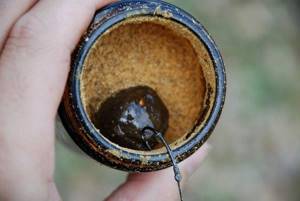
Typically, the list of ingredients in such dips includes palatant (appetite stimulating) extracts (for flavoring), sweeteners and amino acids. I tried several such dips several years ago and did not get a favorable effect, but I don’t think that this experience of mine can be the basis for serious conclusions - there are many good fishermen who consider these dips to be very effective and actively work with them.
What types of dips are there and how should they be used?
There are 3 types of these baits. They all perform one function - they attract fish.
Liquid dips
Liquid dips are “colored” aromatic liquids for soaking boilies, pellets, and other baits in them. Boilie balls (or pellets) are placed in this liquid for a certain time: from a couple of days to a couple of months. During this time, the ball not only acquires a new, more original smell, but also a new color: many dips also serve as a dye for carp baits (especially worth highlighting are the Robin Red series dips from Dynamite Baits, which recolor boilie balls and pellets pellets in rich burgundy tones). The oldest manufacturer of liquid dips is Nutrabaits.
Article on the topic: Pike fishing in winter
Gel dips
Gel dips (or jelly dips) are the same “colored” odorous liquids, only in the form of gels. Gel dips are more functional than their liquid counterparts. Boilie balls, for example, can simply be soaked in gel dip for a couple of days (or more). The effect in this case will be similar to soaking boilies in a liquid dip - pleasantly smelling clouds of turbidity will emanate from the balls when they come into contact with water.
You can sprinkle the already “dipped” ball on top with the base mixture of the same boilie - then the clouds of turbidity will also contain particles of food. The carp will certainly like this addition: it is known that sometimes you can’t “buy” carp with just a pleasant smell. Or you can experiment and prepare some kind of explosive mixture for carp: “deep” boilie balls, say, in a “fruit” gel dip (for 2-7 days), and then sprinkle them with some kind of powder dip (for example, "fishy")
Such explosive mixtures sometimes bring success to the fisherman. Many companies produce high-quality gel dips: Concert For You, Dynamite Baits and others.
Powder dips
Powder dips are colored odorous powders designed for rolling carp baits in them. They are used like this: take a ball of boilies, wet it with water, and “bread” (dip) in aromatic powder. This seemingly primitive method of “deepening” baits is quite effective: when the boilie ball comes into contact with water, the same fragrant clouds of turbidity emanate from it. The best option for those cases when there is no time to soak the nozzle in liquid or gel dip for a long time. Famous manufacturers: Concert For You, Dynamite Baits.
Article on the topic: Rules for correct casting in carp fishing
The main advantage of dips is their ease of use. If you are not sure about the dose of flavoring, you do not want to “chemically” with food coloring, just choose a dip with the desired aroma and color and fill your nozzle with it (for a couple of days - a couple of weeks). Subsequently, the nozzle will acquire not only the taste, but also the color of your dip. It will also spread clouds of turbidity in the water that are attractive to carp.
Nutritional dips
Different manufacturers call these dips differently: food dip, enhancing system, energy dip (nutrient dips, enhancing systems, energy dips). I like the definition of nutritious dips the most, since we are talking about truly highly nutritious and balanced products (nutritive - nutrient). I can say without hesitation: nutritional dips are more effective than any other dips with only a luring effect. They are even more attractive! Their attractive properties are more diverse, and their effect on fish is more complex and lasting in time. So pretty much anything any enticing dip can do, a nutritional dip can do even better.
Therefore, the only question can be: what nutritional dip should I use? And here the fisherman has two options at his disposal: buy a finished product or prepare it yourself. The first option is, of course, completely hassle-free, but also expensive. And, I must say, convenient - you can find many different good quality dips on sale. To be on the safe side, some fishermen try to use the appropriate dip for each boilie, but this is not always necessary. You can easily try dip for boilies “A” with boilies “B” if their compositions are compatible. What, you ask, does it mean: compatible or incompatible? All this is quite conventional, however, in my opinion, you should not use, for example, Belachan dip (Belachan - Fermented Shrimp Paste - fermented shrimp paste) from Select Baits with sweet baits based on birdfood (bird food), but spicy Hot Fish dip goes well with any spicy fishmeal (fishmeal-based boilies).
Correct dips and liquids for cold water

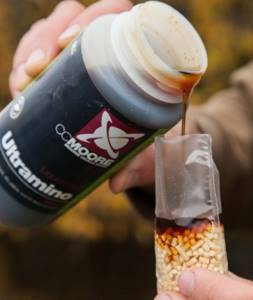
Deepening the bait correctly In winter, it is better to use not dips, but special flavors to make the bait attractive, which should be bright. According to established practice, bright colors attract fish better in cold water. Add just a couple of drops of flavor to a jar of pop-ups or boilies. One of the best cold water flavors by far is Geoff Kemp's series and its warm, creamy varieties. Milk/Ice Cream Flavor, or Mellow Brandy. By the way, a 30kg carp was once caught with the latter, which is one of the records for the winter period!

What to Add to Your Spod Mix During the winter months, it makes sense to create a smoke screen in your swim to stir up inactive fish. This recipe can also be used to prepare “provocation” when fishing with a zig-rig. You will need Milk & Nut Crush sweet bait, as well as Amino Blend 365 liquid. The last three numbers are in its name for a reason. It is equally good in summer and winter and is almost the most versatile liquid in the entire CCMoore line. But still, by all accounts, it is ideal for cold water. Still, in the summer you can rely on much more narrowly targeted additives, but the cold season is the time of Amino Blend 365.
What to add to corn Corn is considered a good additive for carp fishing; almost everyone uses it. But it is even more effective in winter. It is bright, sweet, and is best enhanced with liquid betaine. Liquid Betaine is a very liquid liquid that dissolves well in the coldest water and can further enhance the appeal of a small table of a couple of handfuls of canned or frozen corn.
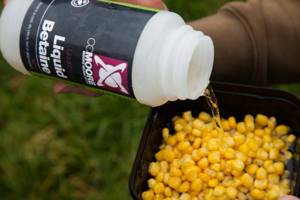
DIY dips
An angler who understands well the essence of how dips work can choose to prepare them himself. They are easy to prepare and, what’s nice, do not clutter up the kitchen like boilies, and we have the opportunity to control the dosage, ingredients and freshness of the product.
The first component that is needed for this is nutritive fluid. To begin with, just one is enough. Dips don't have to have a lot of ingredients - any nutritious liquid is a good dip on its own, especially when added with a hint of flavor or sweetener. Although, of course, several liquids with different properties are usually used at once, which form the so-called dip base. You can add fragrances or essential oils (sometimes both) to this base if necessary.
Theoretically, liquids for the base are selected based on the principle of compatibility with the boilies with which they will be used. But this is only theoretical, since in practice most of them are universal... And carp have their own, sometimes quite unexpected for us, concept of compatibility.
The list of liquids used in nutritional dips is wide. First of all, of course, we should mention easily digestible proteins - Minamino, Amino PPC and all their various types, known under various names. Next come products obtained from the industrial processing of corn or sugar beets (CSL and molasses), fish oils, vegetable oils, natural extracts of shells and crustaceans (belachan, mussels, krill), natural plant extracts (corn, hazelnut, paprika...) , appetite stimulants, soluble fish protein, soluble liver, betaine, natural and artificial sweeteners, flavors, essential oils, etc. And also, last but not least, glycerin. Often glycerin in commercial dips is presented as a bulking ingredient because it makes the dip stick well to the bait and keep the particles in suspension (where needed). Can be used with any aroma, strengthens boilies for a long time and acts as a preservative. Plus, it's cheap.
Nutritional dips are not just liquids. They can successfully include additives in powder form, for example, betaine or palatant extracts. So making dips is a wide creative field, in which the fisherman is limited only by his own imagination.
What are dips?
Dips (from the English to dip - dip) are liquid, gel-like, or powdery, strong additional attractants for carp baits. Unlike flavorings, dips are not added to carp baits during their preparation: on the contrary, ready-made boilies or pellets are soaked (or dipped) in dips to give them new, special flavors. Dip is a kind of “sauce” or “powdered sugar” intended for dipping boilies, pellets, and other carp baits in it on the eve of fishing.
Article on the topic: World Carp Fishing Championship 2015
Currently, three types of dips can be found on the shelves of fishing stores: liquid, gel and powder dip. They differ in the method of application. Their price, by the way, is approximately the same, and ranges from 10 to 30 USD. per bottle (150ml). Each of the three types of dips is used in its own way. Below we will look at them all.
Well, for now, the main question is: why not use a simple liquid “chemical” flavoring instead of dip? Firstly, because not every angler is a cook: when adding flavoring, you must carefully observe the proportions: too much of a dose is very fraught (carps really don’t like “killer” smells). And secondly, dips are not just pleasant-smelling “smells”: dips create the illusion of a “soft bait” (thanks to the cloud of turbidity, the carp thinks that the boilie ball is actually very soft), which also has a positive effect on bites.
It has long been noticed that carp have a liking for soft baits. And thirdly, one does not exclude the other at all: it is quite possible to first provide a boilie with a flavoring agent, and then “dip” it.
Brief list of components
Minamino is the most commonly used liquid in quality nutritional dips. Compatible with any type of boilie. Contains a subtle raspberry aroma, but can be complemented with any other flavors. Minamino has a sweet taste, so the dips in which it is used do not require sweeteners. When used, the boilie softening effect is maintained for a long time. Can be successfully used throughout the season, regardless of water temperature.
CSL is a nutritious liquid that many manufacturers actively use as a base for economy-class dips. Cheap and effective. Combines with any flavors and any types of boilies. It is used with particular success as a dip for corn. Ideally combined with molasses and instant fish protein L-030. Can be used throughout the season, regardless of water temperature.
Liquid liver is a very easily soluble, nutritionally superior ingredient. Has a strong natural aroma. Most often used in dips for boilies based on fishmeal. Effective throughout the season, regardless of water temperature.
Liquid yeast is a nutritional liquid that can be combined with any type of boilie, but is actually most often used with bird food boilie dips. Can be used throughout the season, regardless of water temperature.
L-030 - soluble fish protein. Offered by many manufacturers under different names. Most often used in dips for fishmeal boilies. Being non-oily and completely soluble, it can be used throughout the season, regardless of water temperature. In my opinion, it is excellent in combination with any amino acid liquid such as Minamino as an ingredient for both boilies and dips.
Appetite stimulants are complex nutritional liquids, all natural or with a small amount of synthetic flavoring. Found in various formulas. Can be used throughout the season, regardless of water temperature.
DIY bream dips
Again, we want to present you with 2 options that differ in their basis, but work equally effectively.
Homemade dip for bream fishing based on Minamino:
- liquid yeast – 50 ml;
- nutritional liquid CSL – 100 ml;
- natural protein Minamino – 100 ml.
Again, the ingredients need to be mixed, but flavoring is no longer necessary - this is optional. The fact is that Minamino gives a slight smell of raspberries, which bream (and not only bream) will bite on. This composition will be a wonderful addition to baits made from birdseed.
Spicy dip for bream at home:
- DIY bream dips
coriander and cinnamon – 2 teaspoons each - cloves – 16 pieces
- lemon juice – 8 teaspoons
This is the proportion for 1 liter of sugar syrup (we described above how it is prepared). You need to add and pour spices into it at the boiling stage - after which all that remains is to stir, bring to a homogeneous state, boil and remove from heat. Enriched with additives and cooled, the syrup does not need additional aromatization, as it gives a whole sea of warm aromas, which work especially effectively at cool water temperatures.
Dip recipes
The suggested recipes do not have to be followed exactly; they should be considered simply as suggestions. After all, once having grasped the idea, any angler can create dozens of his own similar recipes, the effectiveness of which will only have to be tested over time.
Dip for baits prepared on the basis of fishmeal: 100ml L-030, 100ml CSL, 50ml Liquid Liver, flavorings.
Dip for baits prepared on the basis of bird food: 100 ml Minamino, 100 ml CSL, 50 ml liquid yeast, flavorings.
The aroma of the dip may be the same as that used in boilies, or it may be different, depending on what tasks you set for yourself. Just be careful not to overdo it with flavorings. I can give this little advice: for 250 ml of nutritional liquid, the dosage of flavoring should not exceed double the dose calculated per kilogram of boilies. For example, if the boilie recipe requires the use of 10 ml of flavor per kilogram of product, then 20 ml can be added to 250 ml of dip.
Essential oils may also be included in the aromatic components. These are wonderful natural products, but when adding them, you need to remember the compatibility of the components. Thus, black pepper essential oil works great in combination with spicy, salty, piquant boilies based on fishmeal or meat protein. But for birdfoods or other sweet baits, floral essential oils, for example, pelargonium (geranium) or bergamot, are more suitable.
In practice, many fishermen prepare dips for certain baits, that is, based on those nutritional fluids and additives that are included in certain boilies. And if the recipe includes a large number of components, then the dip turns out to be of a more complex composition than in the examples given above, but the principle remains the same. It is important to understand here: you can make the dip yourself, and the way you need or want, simple or complex.
